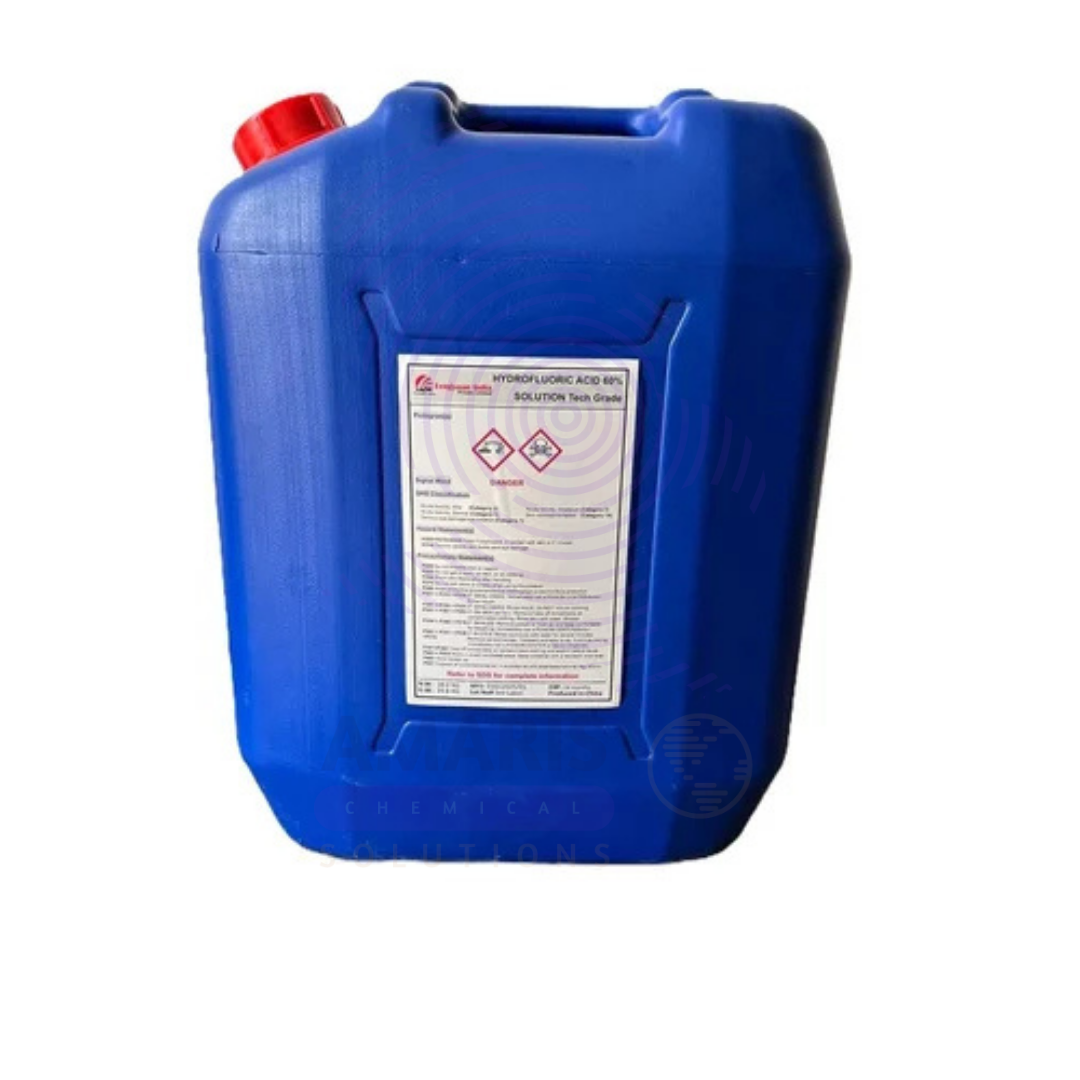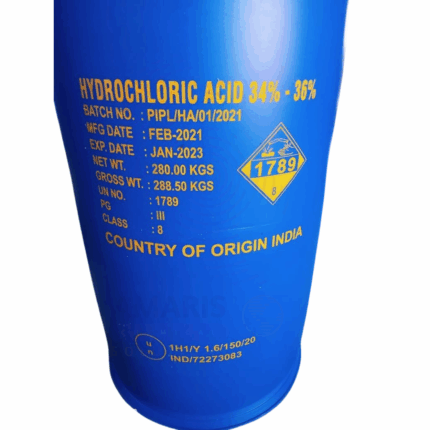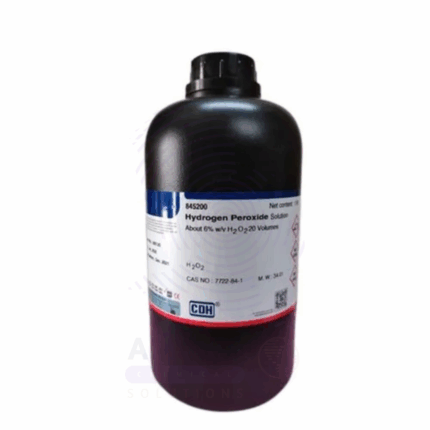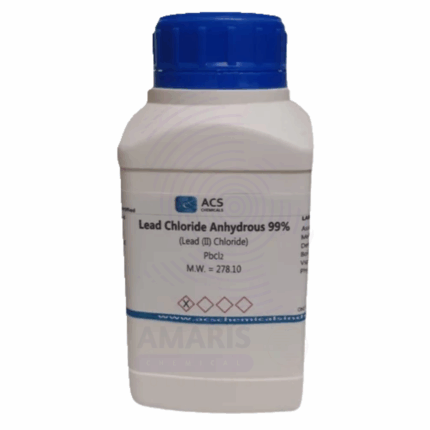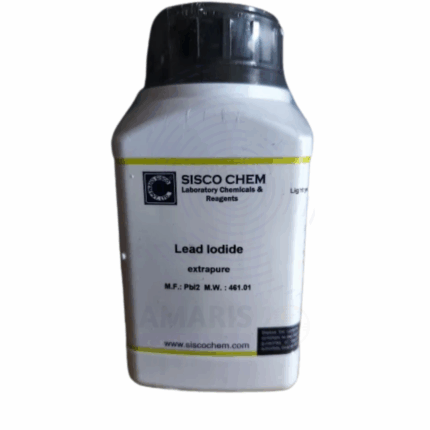Back to products


Hydrogen Peroxide Food Grade
$ 1.55 Original price was: $ 1.55.$ 1.44Current price is: $ 1.44.
Hydrofluoric Acid
$ 7.90 Original price was: $ 7.90.$ 7.74Current price is: $ 7.74.
Whatsapp Order
Hydrofluoric Acid is a highly corrosive aqueous solution of hydrogen fluoride gas dissolved in water. It is a colorless to pale yellow fuming liquid with a strong pungent odor. Unlike other mineral acids, HF is a weak acid chemically but uniquely reactive due to its ability to dissolve silica and glass, and penetrate tissues deeply. This makes it invaluable in numerous industrial, laboratory, and specialized applications but also highly hazardous.
Description
Table of Contents
Toggle
Hydrofluoric Acid
Primary Uses
- Industrial and Manufacturing Applications
- Glass and Quartz Etching: HF is extensively used for precise etching, frosting, and engraving on glass, quartz, and silica-based materials for decorative, optical, and industrial purposes.
- Metal Cleaning and Pickling: Efficient at removing oxides, rust, and scales from stainless steel, aluminum, and other metals prior to plating or fabrication.
- Chemical Synthesis: Key reagent and catalyst in the manufacture of fluorinated compounds, such as hydrofluorocarbons (HFCs), fluoropolymers (e.g., PTFE/Teflon), refrigerants, and pharmaceuticals.
- Petroleum Refining: Used as a catalyst in the alkylation process to produce high-octane gasoline components, improving fuel quality.
- Silicon and Semiconductor Processing: Critical in microelectronics for etching silicon wafers and cleaning delicate components in chip manufacturing.
- Laboratory and Analytical Uses
- Sample Preparation: For elemental analysis, HF digests silicate and mineral samples by dissolving silica matrices to allow metal analysis.
- Surface Treatment: Used to clean and prepare surfaces of ceramics and electronic materials.
- Environmental and Waste Treatment
- Occasionally employed in highly controlled settings to neutralize or break down fluorinated wastes or residues.
Secondary Uses
- Dental and Medical Applications
- Dental Etching: Used at much lower concentrations to etch tooth enamel during restorative dentistry procedures, enhancing bonding of fillings and sealants.
- Art and Craft
- Used by artists and glassmakers to create frost patterns and textures on glass objects and artworks.
- Specialized Industrial Cleaning
- Cleaning of scale and deposits in industrial equipment, pipelines, and reactors where silica or metal oxides accumulate.
- Electronics and Optics
- Etching and cleaning optical fibers, lenses, and precision glass instruments to improve clarity and performance.
- Research and Development
- Used in chemical research for synthesis and as a reagent for fluoride ion introduction in complex organic reactions.
KEY PRODUCT FEATURES
1. Basic Identification Attributes
- Chemical Name (IUPAC): Hydrogen fluoride (aqueous)
- Common/Trade Name: Hydrofluoric Acid 50%
- CAS Number: 7664-39-3
- HS Code: 2811.12.00
- Molecular Formula: HF (aqueous)
- Synonyms: Fluoric acid; Hydrogen fluoride solution
2. Physical & Chemical Properties
- Physical State: Liquid
- Color & Odor: Colorless to pale yellow; sharp, pungent odor
- Boiling Point: Approx. 108 °C at 50% concentration
- Density: ~1.15 g/cm³
- Solubility: Miscible with water
- pH: <1 (strongly acidic)
- Corrosivity: Highly corrosive to skin, glass, metals, and tissues
3. Safety & Hazard Attributes
- GHS Classification:
- Skin corrosion/irritation: Category 1A
- Serious eye damage/irritation: Category 1
- Specific target organ toxicity (single exposure): Category 3 (respiratory irritation)
- Toxicity: Extremely toxic via skin contact, inhalation, and ingestion
- Exposure Limits: OSHA PEL 3 ppm; ACGIH TLV 0.5 ppm (ceiling)
4. Storage & Handling Attributes
- Container Type: Polyethylene, Teflon, or HF-resistant plastic containers only
- Storage Conditions: Cool, dry, ventilated area, away from bases, metals, and oxidizers
- Shelf Life: Stable up to 24 months if stored properly
- Handling Notes: Extreme care with full PPE and emergency protocols
5. Regulatory & Compliance Attributes
- Regulated as hazardous substance by OSHA, EPA, REACH, and transport authorities
- Labeling and documentation required for transport and storage
6. Environmental & Health Impact
- Not biodegradable; environmentally hazardous to aquatic organisms
- Not bioaccumulative but highly toxic in environmental exposures
- No known carcinogenicity but severe acute toxicity and systemic effects
SAFETY HANDLING PRECAUTIONS
Safety Handling Precautions
- PPE: Acid-resistant gloves, full-face shield, protective apron, respirator with acid gas cartridges
- Handling: Use in fume hoods; avoid skin contact and inhalation; calcium gluconate gel must be readily available for emergency treatment
- Hygiene: No eating or smoking; thorough washing after use
First Aid Measures
- Inhalation: Move to fresh air immediately; provide oxygen if necessary; seek urgent medical attention
- Skin Contact: Rinse with water continuously for 15+ minutes; apply calcium gluconate gel; urgent medical care required
- Eye Contact: Flush eyes with water for at least 15 minutes; immediate medical attention essential
- Ingestion: Do NOT induce vomiting; rinse mouth; seek emergency care immediately
Firefighting Measures
- Fire Hazards: Not flammable but reacts with metals releasing flammable hydrogen gas
- Extinguishing Media: Water spray preferred; foam, dry chemical, CO₂ acceptable for surrounding fire
- Precautions: Firefighters require SCBA and acid-resistant gear
- Decomposition Products: Toxic fluorine-containing gases and hydrogen gas
Related products
Double, Triple, Single Lab Pulley
Lab pulleys—available as single, double, or triple configurations—are precision-engineered mechanical devices used in laboratory settings to change the direction of force or lift loads with reduced effort. Typically made from durable materials such as metal alloys or hard plastics, these pulleys consist of grooved wheels that guide ropes or cords smoothly during experiments and mechanical setups. Single pulleys have one wheel, doubles have two, and triples have three wheels, allowing different mechanical advantages depending on the setup. Lab pulleys are essential in physics education, mechanical experiments, and engineering demonstrations where principles of force, tension, and motion are studied.
Hydrochloric Acid
Hydrochloric Acid HCL is a highly corrosive, strong mineral acid consisting of hydrogen chloride gas dissolved in water to a concentration of approximately 33% by weight. It appears as a clear, colorless to slightly yellow liquid with a sharp, pungent odor. HCl 33% is widely used in industrial, chemical, and laboratory applications due to its strong acidic properties, high reactivity, and versatility. It plays a crucial role in pH control, metal processing, chemical synthesis, and cleaning processes across numerous sectors.
Hydrogen Peroxide Extra Pure
Hydrogen Peroxide Extra Pure is a clear, colorless liquid widely used as a strong oxidizing agent in laboratory and industrial settings. This high-purity grade ensures minimal contamination, making it ideal for analytical chemistry, disinfection, bleaching, and redox reactions. In research labs, it serves as a reliable reagent for oxidation processes and sterilization. Its extra pure formulation enhances consistency and accuracy in sensitive procedures. Due to its reactive and potentially unstable nature, it should be stored in cool, dark conditions in vented containers and handled with appropriate protective equipment.
Lead Chloride Anhydrous Extra Pure
Lead Chloride Anhydrous Extra Pure is a white crystalline compound with the chemical formula PbCl₂, offered in its high-purity, moisture-free form for specialized applications. It is only sparingly soluble in cold water but dissolves more readily in hot water, forming a clear solution upon heating. This compound is used in laboratory synthesis, particularly in the preparation of other lead-based reagents, and plays a role in ceramic glazing, pigment production, and electrochemical processes. In research, it is also employed in photographic materials, optical devices, and inorganic analysis. Due to the toxic nature of lead compounds, strict safety protocols are necessary during storage and handling.
Lead Iodide Extra Pure
Lead Iodide Extra Pure is a bright yellow crystalline compound with the formula PbI₂, known for its striking color and high chemical purity, making it ideal for laboratory and research use. It is commonly used in materials science, especially in the fabrication of perovskite solar cells and semiconductors, due to its optical properties and ability to form thin films. In academic research, it plays a role in crystal growth experiments, and its distinct color change upon heating serves as a classic demonstration in chemistry education. Owing to its lead content, appropriate handling precautions and environmental safeguards are essential when working with this compound.
Lead Nitrate Extra Pure
Lead Nitrate Extra Pure is a white crystalline compound (Pb(NO₃)₂) known for its excellent solubility in water and reliable reactivity, making it a key reagent in analytical and industrial chemistry. It is frequently used in laboratory synthesis, qualitative analysis, and in the production of other lead compounds. In pyrotechnics, it's valued for its role as an oxidizing agent, while in metallurgy, it assists in gold leaching and ore processing. Its high purity ensures consistent performance in controlled experiments and manufacturing. Due to its toxic and oxidizing nature, it must be handled with careful PPE protocols and stored securely away from organics or combustible materials.
Lead Shot Extra Pure
Lead Shot Extra Pure consists of small, spherical pellets of high-purity lead, typically used in specialized industrial, laboratory, and ballistic applications. In laboratories, it serves as a dense, inert mass ideal for radiation shielding, counterweights, or ball-milling media due to its excellent malleability and high atomic mass. In metallurgy, it can be employed in alloy preparation or as a reducing agent under specific conditions. Its consistent size and purity make it especially useful where uniformity and minimal contamination are critical. Safe handling is essential, as lead is toxic, and prolonged exposure can pose serious health hazards. Proper PPE, ventilation, and disposal methods are mandatory.
Poly Aluminium Chloride Extra Pure
Poly Aluminium Chloride Extra Pure is a high-efficiency inorganic coagulant widely used in water treatment, paper manufacturing, and various industrial processes. In its extra pure grade, PAC is characterized by a high degree of purity, minimal impurities, and consistent performance, making it suitable for critical applications requiring stringent quality control.
PAC works by neutralizing the negative charges on suspended particles, allowing them to coagulate and settle quickly. It is highly effective in clarifying drinking water, treating industrial and municipal wastewater, and removing heavy metals, organic matter, and pathogens. Additionally, in the paper industry, PAC improves paper strength and retention of fillers.
This compound should be handled with appropriate PPE, including gloves and eye protection, and stored in a cool, dry, and well-ventilated area, away from reactive substances. PAC is non-flammable but may cause irritation on contact with skin or eyes.


 Preservatives(food)
Preservatives(food) Flavor Enhancers
Flavor Enhancers Acidulants
Acidulants Sweeteners
Sweeteners Antioxidants
Antioxidants Colorants(food)
Colorants(food) Nutraceutical Ingredients (food)
Nutraceutical Ingredients (food) Nutrient Supplements
Nutrient Supplements Emulsifiers
Emulsifiers
 Collectors
Collectors Dust Suppressants
Dust Suppressants Explosives and Blasting Agents
Explosives and Blasting Agents Flocculants and Coagulants
Flocculants and Coagulants Frothers
Frothers Leaching Agents
Leaching Agents pH Modifiers
pH Modifiers Precious Metal Extraction Agents
Precious Metal Extraction Agents
 Antioxidants(plastic)
Antioxidants(plastic) Colorants (Pigments, Dyes)
Colorants (Pigments, Dyes) Fillers and Reinforcements
Fillers and Reinforcements Flame Retardants
Flame Retardants Monomers
Monomers Plasticizers
Plasticizers Polymerization Initiators
Polymerization Initiators Stabilizers (UV, Heat)
Stabilizers (UV, Heat)
 Antifoaming Agents
Antifoaming Agents Chelating Agents
Chelating Agents Coagulants and Flocculants
Coagulants and Flocculants Corrosion Inhibitors
Corrosion Inhibitors Disinfectants and Biocides
Disinfectants and Biocides Oxidizing Agents
Oxidizing Agents pH Adjusters
pH Adjusters Scale Inhibitors( water)
Scale Inhibitors( water)
 Antioxidants(cosmetic)
Antioxidants(cosmetic) Emollients
Emollients Fragrances and Essential Oils
Fragrances and Essential Oils Humectants
Humectants Preservatives
Preservatives Surfactants(cosmetic)
Surfactants(cosmetic) Thickeners
Thickeners UV Filters
UV Filters
 Fertilizers
Fertilizers Soil Conditioners
Soil Conditioners Plant Growth Regulators
Plant Growth Regulators Animal Feed Additives
Animal Feed Additives Biostimulants
Biostimulants Pesticides (Herbicides, Insecticides, Fungicides)
Pesticides (Herbicides, Insecticides, Fungicides)
 Active Pharmaceutical Ingredients (APIs)
Active Pharmaceutical Ingredients (APIs) Excipients
Excipients Solvents(pharmaceutical)
Solvents(pharmaceutical) Antibiotics
Antibiotics Antiseptics and Disinfectants
Antiseptics and Disinfectants Vaccine Adjuvants
Vaccine Adjuvants Nutraceutical Ingredients (pharmaceutical)
Nutraceutical Ingredients (pharmaceutical) Analgesics & Antipyretics
Analgesics & Antipyretics
 Analytical Reagents
Analytical Reagents Solvents(lab)
Solvents(lab) Chromatography Chemicals
Chromatography Chemicals Spectroscopy Reagents
Spectroscopy Reagents microbiology-and-cell-culture-reagents
microbiology-and-cell-culture-reagents Molecular Biology Reagents
Molecular Biology Reagents Biochemical Reagents
Biochemical Reagents Inorganic and Organic Standards
Inorganic and Organic Standards Laboratory Safety Chemicals
Laboratory Safety Chemicals Specialty Laboratory Chemicals(Special Laboratory Equipment)
Specialty Laboratory Chemicals(Special Laboratory Equipment)
 Demulsifiers
Demulsifiers Hydraulic Fracturing Fluids
Hydraulic Fracturing Fluids Scale Inhibitors(oil)
Scale Inhibitors(oil) Surfactants(oil)
Surfactants(oil) Drilling Fluids
Drilling Fluids
 Dyes and Pigments
Dyes and Pigments Bleaching Agents
Bleaching Agents Softening Agents
Softening Agents Finishing Agents
Finishing Agents Antistatic Agents
Antistatic Agents
 Admixtures
Admixtures Waterproofing Agents
Waterproofing Agents Sealants and Adhesives
Sealants and Adhesives Curing Compounds
Curing Compounds Concrete Repair Chemicals
Concrete Repair Chemicals Anti-Corrosion Coatings
Anti-Corrosion Coatings
 Surfactants(cleaning)
Surfactants(cleaning) Builders
Builders Enzymes
Enzymes Solvents (Cleaning)
Solvents (Cleaning) Fragrances
Fragrances
 Electronic Chemicals
Electronic Chemicals Catalysts
Catalysts Lubricants
Lubricants Photographic Chemicals
Photographic Chemicals Refrigerants
Refrigerants Automotive chemicals
Automotive chemicals Pyrotechnic Chemicals
Pyrotechnic Chemicals
 Biodegradable Surfactants
Biodegradable Surfactants Bio-based Solvents
Bio-based Solvents Renewable Polymers
Renewable Polymers Carbon Capture Chemicals
Carbon Capture Chemicals Wastewater Treatment Chemicals
Wastewater Treatment Chemicals
 Pigments
Pigments Solvents(paint)
Solvents(paint) Specialty Coatings
Specialty Coatings Binders/Resins
Binders/Resins Additives
Additives Driers
Driers Anti-Corrosion Agents
Anti-Corrosion Agents Functional Coatings
Functional Coatings Application-Specific Coatings
Application-Specific Coatings
 Fresh Herbs
Fresh Herbs Ground Spices
Ground Spices Whole Spices
Whole Spices Spice Blends
Spice Blends Dried Herbs
Dried Herbs
 Leavening Agents
Leavening Agents Dough Conditioners
Dough Conditioners Flour Treatments
Flour Treatments Fat Replacers
Fat Replacers Decoratives
Decoratives Preservatives(baking)
Preservatives(baking)
 Plasticizers & Softeners
Plasticizers & Softeners Reinforcing Agents
Reinforcing Agents Adhesion Promoters
Adhesion Promoters Vulcanizing Agents
Vulcanizing Agents Antidegradants
Antidegradants Blowing Agents
Blowing Agents Fillers & Extenders
Fillers & Extenders Accelerators & Retarders
Accelerators & Retarders